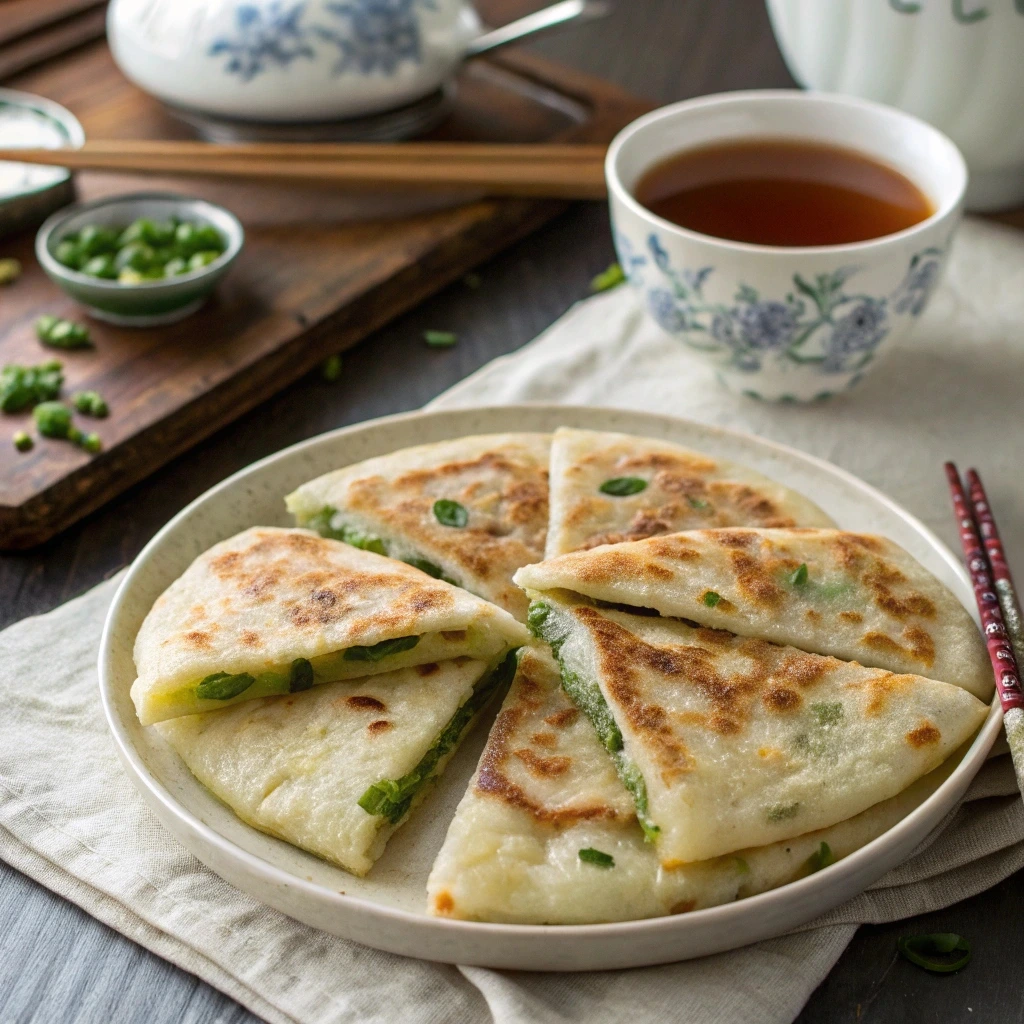If you’ve ever taken a bite of a perfectly crisp, golden-brown scallion pancake—crackling on the outside, flaky and chewy inside—you know it’s something unforgettable. Whether served as a street snack in Taiwan or a homestyle breakfast in northern China, scallion pancakes (known as cong you bing in Mandarin) are pure comfort food. But what’s the secret behind their irresistible layers?
In this comprehensive guide, we’ll walk you through everything you need to know: from the dough’s science and folding techniques, to creative variations, dipping sauces, freezing tips, and even common mistakes to avoid. Whether you’re a seasoned cook or a curious foodie, you’ll discover why this humble dish has taken the global culinary world by storm.
Ready to master the flakiest scallion pancakes of your life? Let’s dive in.
Table of Contents
Introduction to Scallion Pancakes
What Are Scallion Pancakes?
Scallion pancakes—or cong you bing (葱油饼)—are savory, unleavened flatbreads packed with chopped scallions and pan-fried until golden and crisp. But don’t let the word “pancake” fool you; these aren’t your typical fluffy breakfast stack. Instead, they’re chewy, flaky, and bursting with umami thanks to the sizzling oil and green onion layers folded deep within.
Unlike Western pancakes, Chinese scallion pancakes are made using dough, not batter. That’s one key difference that gives them their signature chewy texture and layered bite. Think of them more like a hybrid between flatbread and croissant—just without all the butter.
Why They’re So Popular
One bite and you’ll see why these crispy Chinese pancakes are adored all over Asia—and now, across the globe. They’re budget-friendly, made with pantry staples, and endlessly versatile. From busy Beijing street vendors to home kitchens in Taiwan, scallion pancakes are often enjoyed as a side dish, snack, or even breakfast on-the-go.
Moreover, they pair beautifully with congee, soups, or spicy dipping sauces. And the best part? You can make them ahead, freeze them, and fry them up whenever the craving strikes. In short, they’re a culinary crowd-pleaser that checks every box: flavor, texture, and ease.
Stay tuned—because next, we’re taking a flavorful trip through the history of this iconic dish.
Cultural and Historical Background
Origins of Cong You Bing
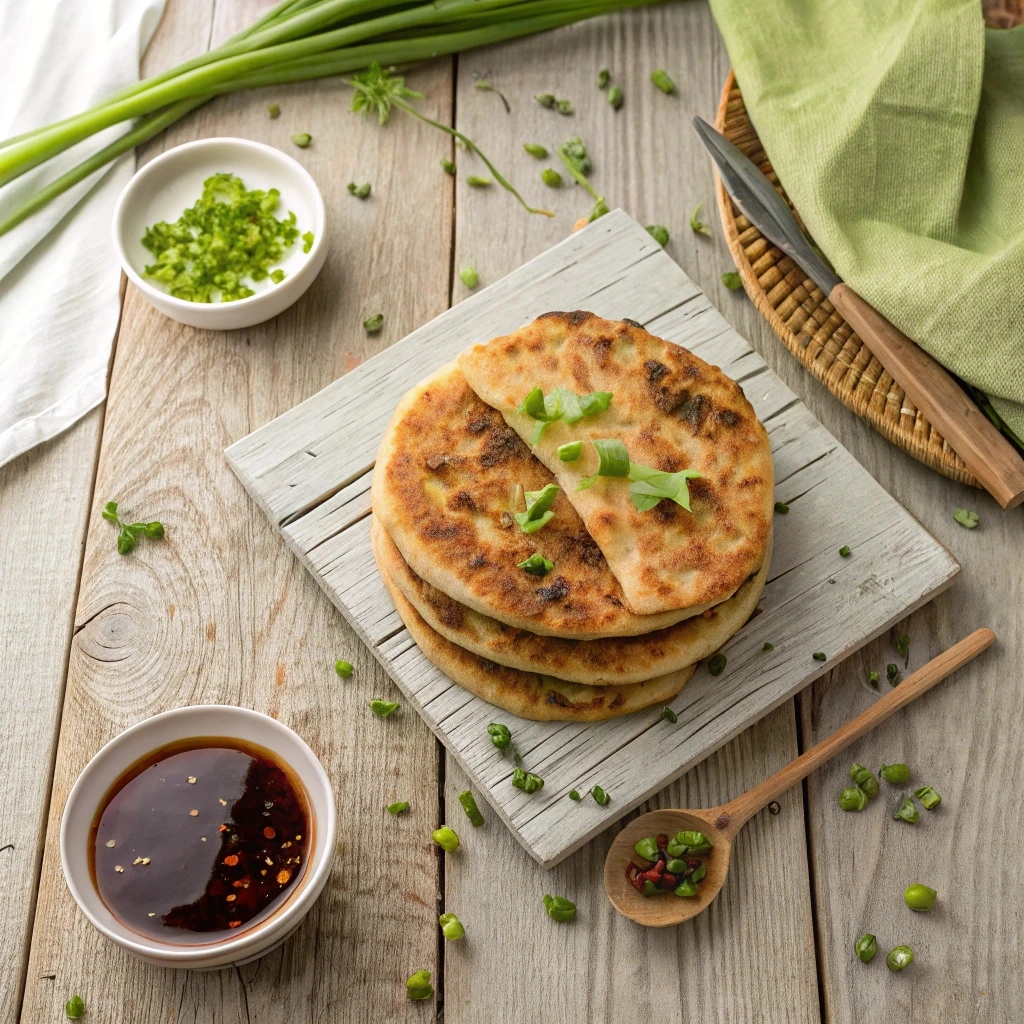
The roots of Scallion Pancakes run deep into the rich soil of Chinese culinary history. Known locally as cong you bing (葱油饼), these savory flatbreads date back centuries and are believed to have originated in northern China. Some food historians suggest their ancestry goes as far back as the Song Dynasty.
Interestingly, unlike many complex Chinese recipes, scallion pancakes remain a dish of the people—simple, hearty, and made with few ingredients. They were traditionally cooked on large griddles and served hot as breakfast or a midday snack.
While you may come across a similar preparation in other cuisines, such as Indian paratha, don’t be fooled. Although both are layered and pan-fried, the dough and flavor profiles are entirely unique. Scallion pancakes rely on oil-based lamination, not ghee or butter, and always spotlight the bold, aromatic bite of fresh scallions.
Cultural Significance in China and Taiwan
Throughout China and Taiwan, scallion pancakes are more than just comfort food—they’re part of daily life. In bustling Taiwanese night markets, vendors skillfully shape and fry these pancakes to order. Meanwhile, in many Chinese households, they’re passed down as a “first dish” taught to new cooks.
Moreover, because they’re vegetarian, they’re popular among Buddhist families and during meatless holidays. In addition, their low cost and high flavor make them a beloved choice across all social classes.
Over time, the popularity of Chinese scallion pancakes has crossed borders. From food trucks in Los Angeles to brunch menus in London, their global reach continues to grow.
As a result, what was once a simple street food has become a global sensation—yet it still holds tight to its humble, crispy roots.
Core Ingredients and Tools
Essential Ingredients for Scallion Pancakes
To make authentic scallion pancakes, you don’t need fancy gadgets or expensive ingredients. In fact, one of the reasons this dish is so popular is its simplicity. However, the right flour and oil can make or break the texture.
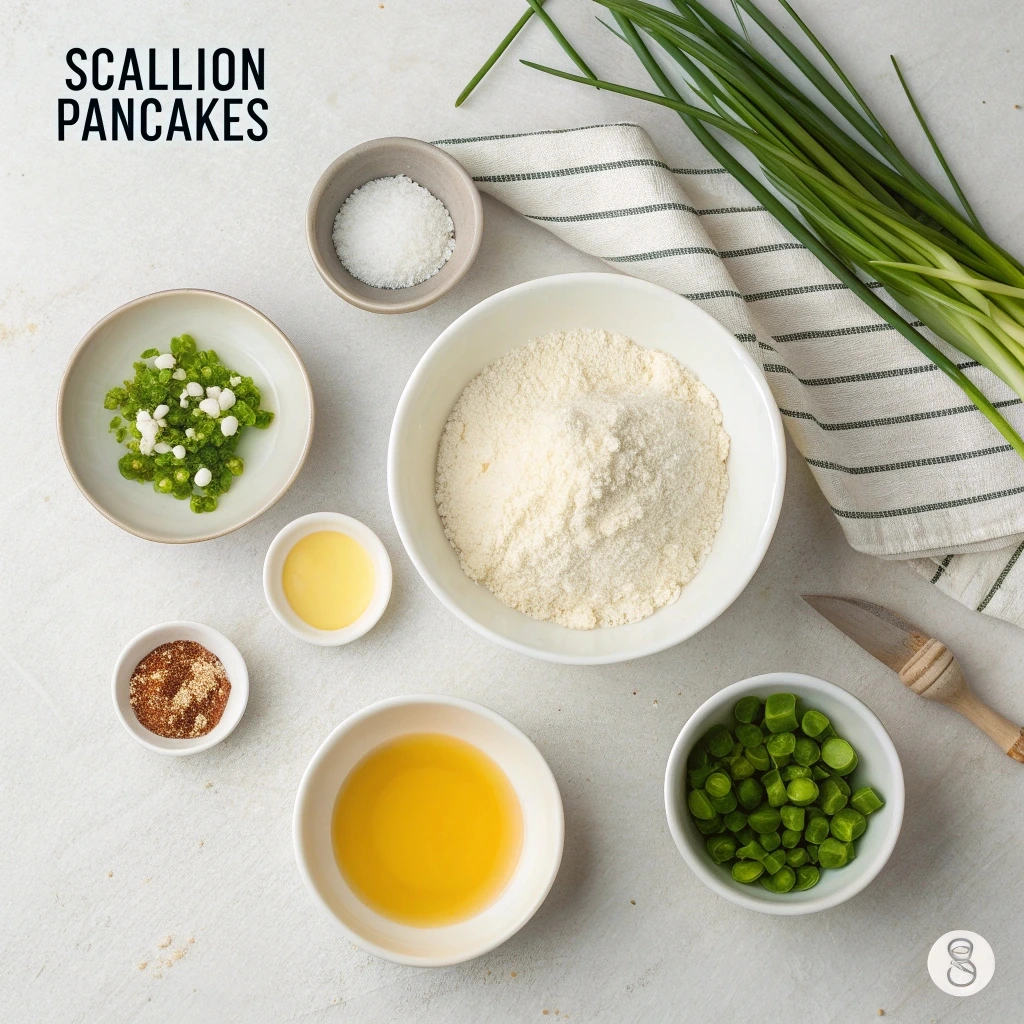
Here’s a handy table with all the core ingredients and their quantities for a standard 6-pancake batch:
| Ingredient | Quantity |
|---|---|
| All-purpose flour | 2½ cups (360g) |
| Cake flour | 1½ cups (216g) |
| Hot water | 1 cup (237g) |
| Cold water | ½ cup + 2 tbsp (148g) |
| Salt (for dough) | ½ teaspoon |
| Scallions (green onions) | 1 cup, chopped (about 6 scallions) |
| All-purpose flour (paste) | ½ cup + 2 tbsp (90g) |
| Vegetable oil (for paste) | ½ cup (120ml) |
| Salt (for paste) | 1½ teaspoons |
| Sichuan pepper powder | 1½ teaspoons (optional) |
These pantry-friendly items come together to create something magical. The combo of hot and cold water in the dough is key—it relaxes the gluten just enough to create chewy, tender layers.
Recommended Kitchen Tools
Although you can technically make scallion pancakes with just your hands and a skillet, a few kitchen tools will make things much easier:
- Rolling pin – To shape thin, even sheets of dough
- Pastry brush – To apply the oil-flour-scallion paste
- Non-stick pan or griddle – For even frying and crispy edges
- Food scale – Ensures precision, especially when combining flours
Moreover, it’s helpful to have parchment paper if you plan to freeze uncooked pancakes for later use. Trust us, once you make a batch, you’ll wish you had more ready to go!
Secrets to the Perfect Dough
Hot Water Dough Technique
When it comes to scallion pancakes, nailing the dough is half the battle. Unlike bread dough, which needs gluten to rise, pancake dough needs just enough chew without being rubbery. That’s where the hot water dough technique shines.
Start by pouring boiling water into your flour mixture. This quick blast of heat partially cooks the starches, making the dough soft and pliable. Moreover, it helps control gluten development so the pancakes remain tender, not tough. Once the hot water is mixed in, follow with a touch of cold water to bring the dough together.
Be warned: if your dough feels dry or stiff, your pancakes will likely come out dense. On the flip side, if it’s too wet, rolling becomes a sticky mess. Therefore, aim for a soft, slightly tacky texture—one that springs back gently when pressed.
Chilling for Texture
Here’s a secret most recipes won’t tell you—chill your dough. Seriously. Letting it rest in the fridge overnight relaxes the gluten, making it easier to roll out without shrinking back. Plus, cold dough is key to achieving that beautiful, crackly crisp exterior and defined layers.
Some home cooks chill after kneading, while others wait until the pancakes are coiled and ready to roll. Honestly, both methods work, but chilling after shaping gives the oil paste a chance to firm up, which enhances the layering effect.
If you enjoy savory, flaky Chinese comfort food, you might also love this Chinese Meat Pie Recipe—another handheld delight that pairs crispy layers with bold flavors.
Folding Techniques for Layered Perfection
Why Folding Style Matters
Alright, let’s talk layers. Scallion pancakes aren’t just about the ingredients—they’re about technique. And one of the biggest game changers? How you fold the dough.
Because the goal is flaky layers, how you roll and coil the dough directly affects the texture. Think of it like puff pastry: layers of dough and oil trap steam during cooking, causing separation and crispness. So if you want restaurant-level results, it’s worth experimenting with different folding styles.
Moreover, some methods are faster, while others deliver more dramatic flakiness. Therefore, choose based on your comfort level and time.
Top 6 Folding Techniques for Scallion Pancakes
Here are six popular methods to fold and shape scallion pancakes, each with its own perks:
- Basic Spiral (Jelly Roll + Snail Coil)
Roll the dough into a rectangle, spread with paste, roll into a log, and coil. Simple and reliable. - Scroll Method
Roll both long sides inward to meet in the middle, then fold. This creates multi-directional layers—extra flake! - Accordion Fold
Like folding a fan. Produces dramatic, stacked edges and a slightly chewier bite. - Cut + Roll Technique
Make horizontal cuts before rolling. The result? Stringy, shredded textures like “shou zhua bing”—a cousin to scallion pancakes. - Flat Layer Stack
Instead of rolling, layer like lasagna sheets. This hides the scallions inside but gives an incredibly crispy crust. - Noodle Pancake
Coat both sides, slice into strips, and layer. The most effort—but it yields chaotic, crunchy magic.
Each method brings something unique to the table, so don’t be afraid to play around. Who knows? You might discover your signature style.
For more delicious Asian-style snack recipes, check out our full recipe collection on PopinRecipes. You’re bound to find new favorites that match the flaky, crispy goodness of scallion pancakes.
Step-by-Step Cooking Guide
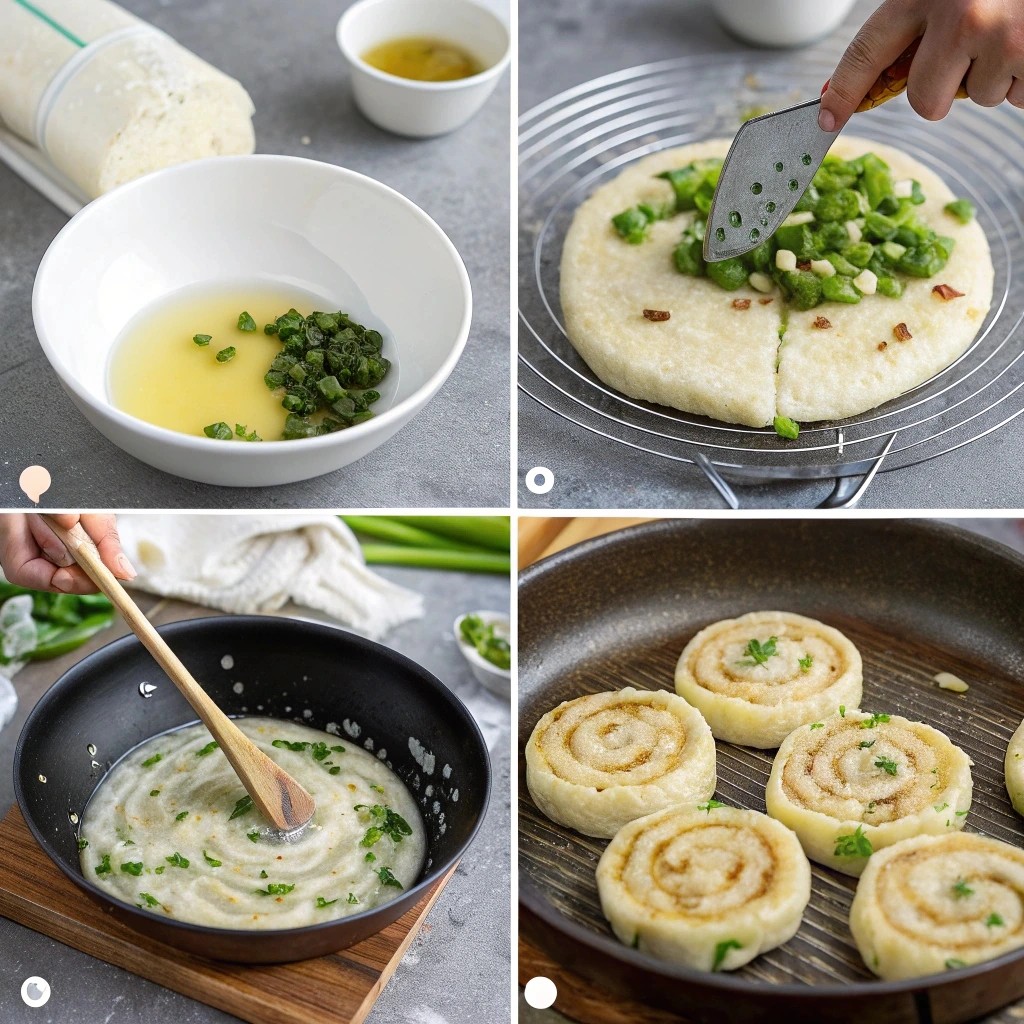
Rolling and Shaping the Pancakes
Once your dough has rested—preferably overnight for best texture—it’s time to shape the scallion pancakes. First, divide the dough into equal pieces (about 6 portions for a standard batch). Then, roll one piece into a thin rectangle on a lightly floured surface. The thinner the better, but be careful not to tear the dough.
Next, spread a thin, even layer of your scallion-oil-flour paste. Use a pastry brush or spoon, making sure to reach all edges. Now comes the fun part—rolling and coiling. Depending on the folding style you choose (spiral, accordion, or scroll), you’ll roll the dough into a rope, coil it into a disk, and let it rest again for 10 minutes.
After resting, flatten the coil gently with your palm, then roll it into a round pancake about ¼ inch thick. Don’t worry if it’s not perfectly round; rustic shapes still fry up beautifully!
If you made extras, this is the perfect point to freeze them. Just place parchment paper between each pancake, stack them in a freezer bag, and they’re ready to go anytime.
Frying to Golden Perfection
Now it’s time to bring the heat. Place a non-stick pan over medium heat and brush it with a thin layer of oil. When the oil shimmers, gently lay one pancake in the pan. Cover it with a lid and let it cook for 3 minutes.
Then, flip it over, cover again, and cook for another 2–3 minutes. The lid helps trap steam, making the inside tender while the outside crisps up. Remove the lid and continue frying both sides uncovered for another minute if needed, until both are deeply golden.
Before serving, give the pancake a gentle shove using two spatulas. This helps loosen and separate the flaky layers. Repeat with the rest—and voilà! Hot, crispy, chewy scallion pancakes ready to devour.
Serving Suggestions and Dipping Sauces
How to Serve Scallion Pancakes
One of the best things about scallion pancakes? They’re as versatile as they are delicious. You can slice them into wedges, serve them whole, or even cut them into strips for dipping. While they’re often eaten on their own, they also make a great side dish.
In China and Taiwan, people enjoy them with congee, soups, or cold dishes. However, they’re also fantastic on Western-style brunch plates—think avocado, fried egg, or grilled veggies. You can even use them as a wrap or sandwich base for a fusion twist.
Moreover, they pair wonderfully with sauces, which brings us to the next delicious detail…
Classic and Creative Dipping Sauces
The most traditional sauce for scallion pancakes is simple and bold: soy sauce, black vinegar, minced ginger, and a touch of brown sugar. Want a kick? Add chili oil or chopped garlic.
Here’s a basic recipe you can try:
- 2 tbsp soy sauce
- 1 tbsp Chinese black vinegar
- 1 tsp brown sugar
- 1 tsp fresh grated ginger
- Optional: chili flakes or chopped green chili
Alternatively, you can dip them into hoisin sauce, garlic soy glaze, or even spicy mayo for a modern twist.
The crisp, savory flavor of scallion pancakes begs for bold contrasts—and these dipping sauces deliver just that.
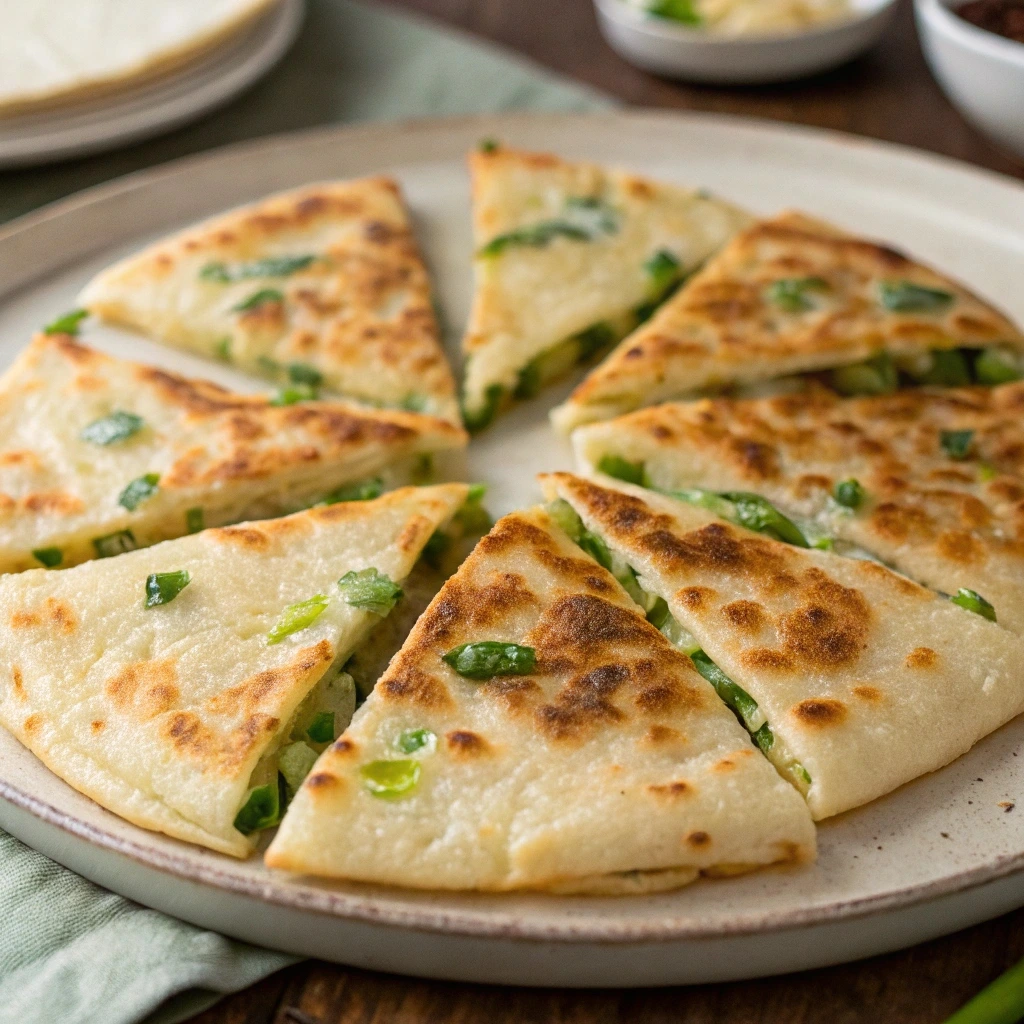
Variations and Modern Twists
Regional and Personal Adaptations
While scallion pancakes are rooted in tradition, they’ve also evolved across regions—and kitchens. In northern China, they tend to be thicker and chewier, with a hearty bite. On the other hand, the Taiwanese version is often thinner, crispier, and more layered, usually cooked with a generous amount of oil.
Moreover, some families add sesame seeds to the dough or sprinkle them on top before frying. This small twist brings an extra layer of nutty flavor. Others even incorporate garlic chives or finely diced onions in place of—or alongside—the scallions.
Meanwhile, street vendors in Taiwan have taken things up a notch by stuffing pancakes with eggs, cheese, or even sliced meats. These versions are often cooked to order and folded like a taco—a real treat for anyone craving variety.
Fusion Ideas and International Takes
As scallion pancakes gain global popularity, creative takes continue to pop up in kitchens everywhere. For example, some cooks now make them gluten-free using rice flour or gluten-free all-purpose blends. While these don’t replicate the exact texture, they’re still crispy and satisfying.
Others stuff the pancakes with gooey mozzarella or cheddar for a savory surprise. You might even spot sweet versions that skip the scallions and add cinnamon-sugar or red bean paste.
Additionally, turning scallion pancakes into mini flatbread pizzas has become a fun way to fuse cultures. Just top them with your favorite spreads, slice, and serve.
In short, the possibilities are endless. While tradition lays the foundation, modern cooks have shown there’s no limit to what you can create from this humble dough.
Storage and Freezing Tips
Best Way to Store Uncooked Pancakes
Planning to make a big batch of scallion pancakes? Good call. They freeze beautifully and are perfect for busy weekdays.
First, after rolling the pancakes flat, place a piece of parchment paper between each one. Then, stack and store them in a zip-top freezer bag. They’ll keep well for up to one month.
You don’t need to thaw them before frying—just pop them into a hot pan and cook as usual. However, you may want to lower the heat slightly to ensure the inside cooks evenly.
Reheating for Maximum Crispness
Already cooked a few and have leftovers? Don’t worry—they reheat well too. To bring back that signature crunch, skip the microwave. Instead, warm them in a non-stick pan over medium heat for 2–3 minutes on each side.
You can also use an air fryer at 350°F for 4–5 minutes. This method keeps the outside crisp and the inside chewy—just like fresh-off-the-pan scallion pancakes.
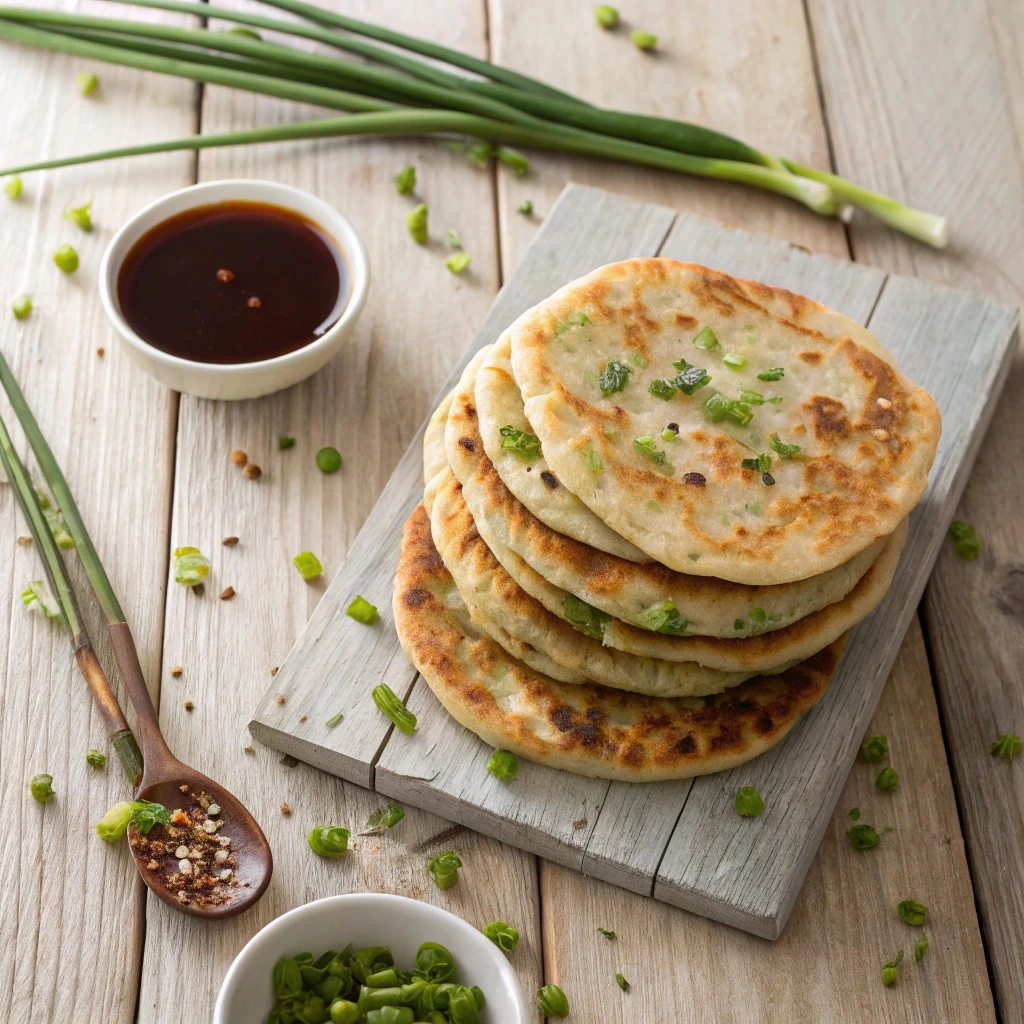
Common Mistakes and Troubleshooting
Dough Too Tough or Sticky?
Getting the dough right is half the battle when making scallion pancakes. If your dough turns out too tough, chances are you used too much flour or didn’t add enough hot water. This limits gluten control, which leads to a chewy—not tender—texture.
On the flip side, if the dough feels overly sticky, you may have added too much water. In that case, add small pinches of flour while kneading until the dough becomes soft but manageable. Moreover, remember not to over-knead. A light hand keeps the layers tender and easy to roll.
Flat, Not Flaky?
One of the biggest disappointments with scallion pancakes is ending up with a flat, bread-like round instead of those glorious, flaky layers. This usually happens when the oil paste is uneven, the dough wasn’t chilled, or the folding technique wasn’t tight enough.
Therefore, make sure your paste is spread edge to edge and give the dough time to rest—especially after shaping. This helps create distinct layers that puff and crisp during frying.
Additionally, always press gently when rolling out the final pancake. If you push too hard, you risk compressing the layers, which defeats the purpose of folding them in the first place.
FAQs — People Also Ask
What is the difference between scallion pancakes and roti?
Although both are flatbreads, scallion pancakes and roti are quite different. Roti is usually unleavened, made with whole wheat flour, and doesn’t use oil between layers. Scallion pancakes, however, are layered with an oil-flour paste and filled with scallions, creating a flakier and more savory bite.
Can I make scallion pancakes gluten-free?
Yes, you can! While the texture won’t be exactly the same, you can use a gluten-free flour mix to create a close version. Adding a bit of xanthan gum or psyllium husk helps mimic the stretch of gluten. Just be careful while rolling, as the dough may tear more easily.
Why are my scallion pancakes not crispy?
A few reasons could be to blame. First, you might not be using enough oil in the pan. Second, the heat may be too low. Scallion pancakes need medium to medium-high heat to crisp up. Lastly, rolling them too thin or skipping the rest time can also impact the final crunch.
How do you get the layers in scallion pancakes?
The secret lies in the folding method and the oil paste. By rolling, coiling, and chilling the dough with the scallion-oil mixture in between, you create laminated layers that separate as they cook. Think of it as a savory version of croissant technique—only much easier.
Can I use green onions instead of scallions?
Yes, absolutely! In fact, scallions and green onions are the same thing in most grocery stores. So whether the label says “scallions” or “green onions,” you’re good to go.

